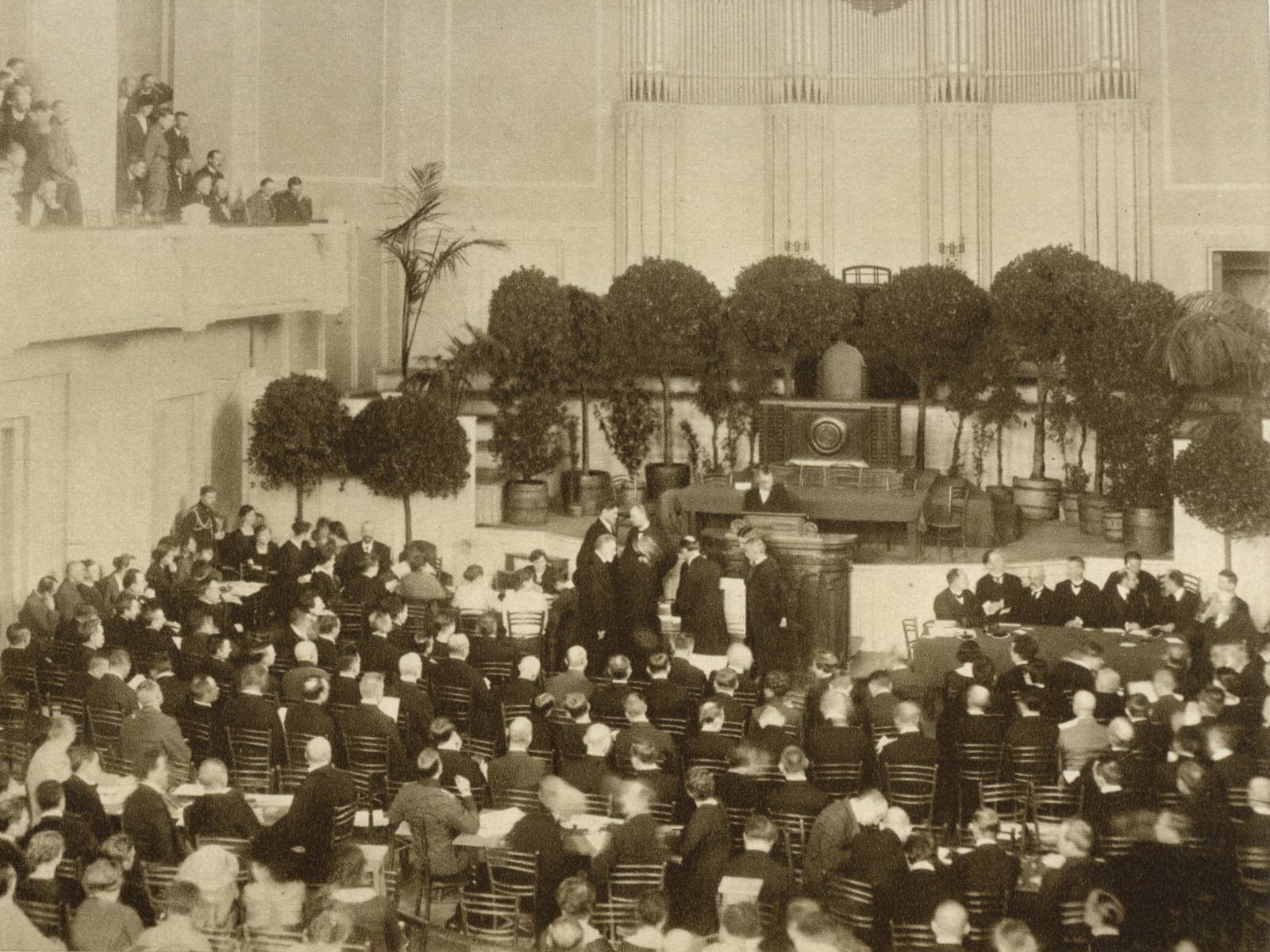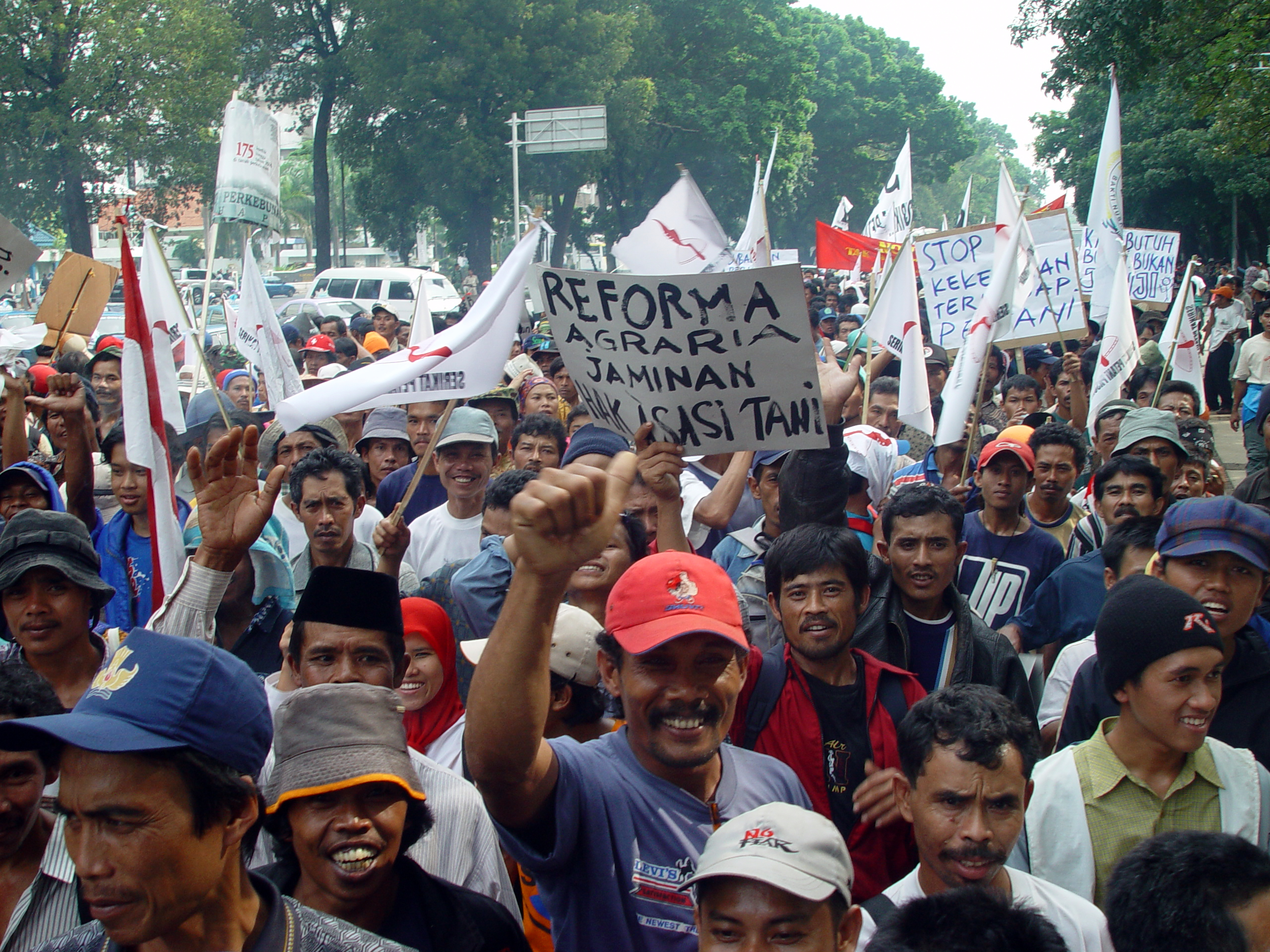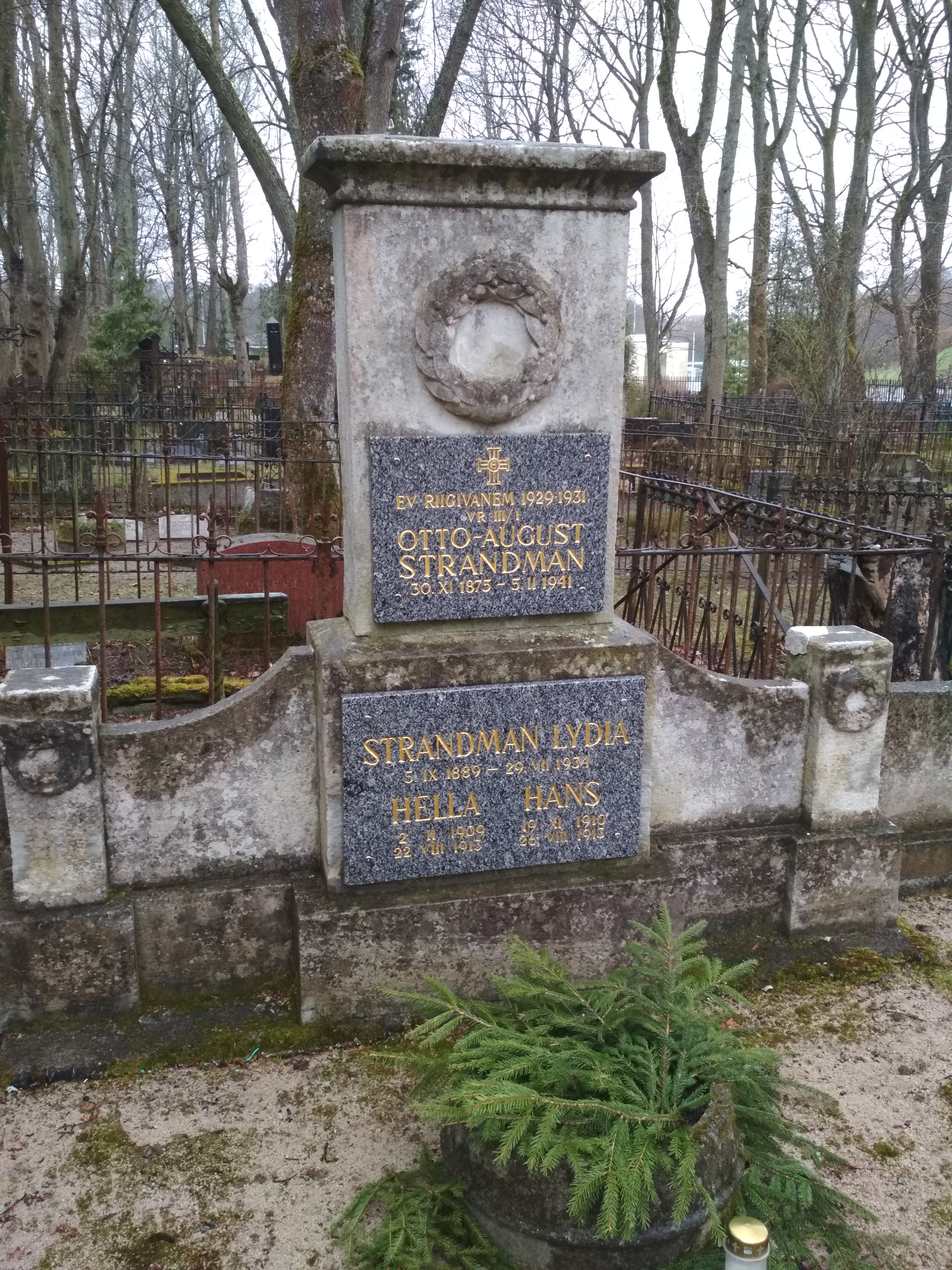|
Estonian Constituent Assembly
The Estonian Constituent Assembly () was elected on 5–7 April 1919, called by the Estonian Provisional Government during the Estonian War of Independence. Estonian Constituent Assembly elections Activity The 120 members of the Constituent Assembly met at the opening session on 23 April 1919, the birthday of the Estonian Parliament and elected the chairman, Social Democrat August Rei. On 7 May, the Assembly passed the Public Elementary Schools Act: The principle of compulsory and free primary 6-year elementary school education was established. On 8 May 1919, the Estonian provisional government resigned, and the first fully democratically elected Government of Estonia headed by Prime Minister Otto Strandman (Estonian Labor Party) took office. On 15 May, the assembly reaffirmed the Estonian Declaration of Independence, aimed at the international community for recognizing Estonia as an independent state. On 4 June 1919, the Assembly adopted a temporary Constitution of Eston ... [...More Info...] [...Related Items...] OR: [Wikipedia] [Google] [Baidu] |
Estonian Provisional Government
The Estonian Provisional Government () was formed on 24 February 1918, by the Salvation Committee appointed by '' Maapäev'', the Estonian Province Assembly. History Konstantin Päts' first provisional cabinet The Provisional Government was led by Konstantin Päts. Jüri Vilms was appointed minister of justice, Jaan Poska minister of foreign affairs, Juhan Kukk minister of finance, Jaan Raamot minister of food and agriculture, Andres Larka minister of war. Villem Maasik was minister of labour and welfare, Ferdinand Peterson minister of roads and Peeter Põld minister of education. The main functions of the Provisional Government were lobbying for diplomatic recognition for Estonian independence abroad, oppose the German occupation of Estonia and organise elections to the Estonian Constituent Assembly. After the formation of the Provisional Government, the country was occupied by German troops and became administered by Ober Ost. As the result of German revolution and ca ... [...More Info...] [...Related Items...] OR: [Wikipedia] [Google] [Baidu] |
Land Reform
Land reform (also known as agrarian reform) involves the changing of laws, regulations, or customs regarding land ownership, land use, and land transfers. The reforms may be initiated by governments, by interested groups, or by revolution. Land reform is often considered a contentious process, as land is a key driver of a wide range of social, political and economic outcomes. The structure and distribution of land rights has been linked to state formation, economic growth, inequality, political violence, and identity politics, making land reform highly consequential for the long-term structures of society. Overview Land reform may consist of a government-initiated or government-backed property redistribution, generally of agricultural land. Land reform can, therefore, refer to transfer of ownership from the more powerful to the less powerful, such as from a relatively small number of wealthy or noble owners with extensive land holdings (e.g., plantations, large ranches, or ... [...More Info...] [...Related Items...] OR: [Wikipedia] [Google] [Baidu] |
Politics Of Estonia
Politics in Estonia takes place in a framework of a parliamentary representative democratic republic, whereby the Prime Minister of Estonia is the head of government, and of a multi-party system. Legislative power is vested in the Estonian parliament. Executive power is exercised by the government, which is led by the prime minister. The judiciary is independent of the executive and the legislature. Estonia is a member of the United Nations, the European Union, and NATO. History The Estonian Declaration of Independence was issued on 21 February 1918. A parliamentary republic was formed by the Estonian Constituent Assembly and the first Constitution of Estonia was adopted on 15 June 1920. The Parliament of Estonia (State Assembly) elected a Riigivanem who acted both as Head of Government and Head of State. During the Era of Silence, political parties were banned and the parliament was not in session between 1934 and 1938 because the country was ruled by decree of Konstantin ... [...More Info...] [...Related Items...] OR: [Wikipedia] [Google] [Baidu] |
1920 Estonian Parliamentary Election
Parliamentary elections were held in Estonia between 27 and 29 November 1920, the first held under the 1920 constitution. 100 deputies were elected into the new Riigikogu by party lists in 10 regions, by which one party or electoral bloc could put up several lists in one region. Seats were still distributed on the state level, where votes for different lists were summed up by their political affiliation and then seats distributed using d'Hondt formula. Thereafter seats for one party or bloc were distributed between different lists of that political force using the same formula. Results See also * I Riigikogu References *II Riigikogu valimised : 5.-7. mail 1923 / Riigi Statistika Keskbüroo = Élections au parlement : de 5.-7. mai 1923 / Bureau Central de Statistique de l'Estonie - Tallinn : Riigi Statistika Keskbüroo, 1923 (Tallinn : Tallinna Eesti Kirjastus-Ühisus; Narva : M. Minis) Parliamentary elections in Estonia Estonia Parliamentary Estonia Estonia, official ... [...More Info...] [...Related Items...] OR: [Wikipedia] [Google] [Baidu] |
Russian SFSR
The Russian Soviet Federative Socialist Republic (Russian SFSR or RSFSR), previously known as the Russian Socialist Federative Soviet Republic and the Russian Soviet Republic, and unofficially as Soviet Russia,Declaration of Rights of the laboring and exploited people, article I. was a socialist state from 1917 to 1922, and afterwards the largest and most populous constituent republic of the Soviet Union (USSR) from 1922 to 1991, until becoming a sovereign part of the Soviet Union with priority of Russian laws over Union-level legislation in 1990 and 1991, the last two years of the existence of the USSR.The Free Dictionary Russian Soviet Federated Socialist Republic . Encyclopedia2.thefreedictionary.com. Retrieved on 22 June 2011. The Russ ... [...More Info...] [...Related Items...] OR: [Wikipedia] [Google] [Baidu] |
Livonian Crusade
The Livonian crusade consists of the various military Crusade, Christianisation campaigns in medieval Livonia – modern Latvia and Estonia – during the Pope, Papal-sanctioned Northern Crusades in the 12th–13th century. Overview Historical sources The main source of information on the Livonian crusade is the ''Livonian Chronicle of Henry'', written in 1229 by Henry of Latvia (''Henricus de Lettis''). In his chronicle, the author notes that he penned it down at the urging of his lords and companions, including his former teacher bishop Albert of Riga, who receives much praise throughout the text, that is internally divided according to the years of Albert's episcopate. James A. Brundage (1972) posited that Albert commissioned Henry to write the ''Livonian Chronicle'' in the mid-1220s in order to glorify Albert's achievements, as well as to briefly summarise unresolved issues to the newly appointed papal legate, William of Modena. Henry wrote that the papacy's use of the ... [...More Info...] [...Related Items...] OR: [Wikipedia] [Google] [Baidu] |
Baltic German
Baltic Germans ( or , later ) are Germans, ethnic German inhabitants of the eastern shores of the Baltic Sea, in what today are Estonia and Latvia. Since Flight and expulsion of Germans (1944–1950), their resettlement in 1945 after the end of World War II, Baltic Germans have drastically declined as a geographically determined ethnic groups in Europe, ethnic group in the region, with diaspora generally relocating to Germany proper and beyond. Since the late Middle Ages, native German-speakers formed the majority of merchants and clergy, and the large majority of the Baltic nobility, local landowning nobility who effectively constituted a ruling class over indigenous Latvians, Latvian and Estonians, Estonian non-nobles. By the time a distinct Baltic German ethnic identity began emerging in the 19th century, the majority of self-identifying Baltic Germans were non-nobles belonging mostly to the urban and professional middle class. In the 12th and 13th centuries, Catholic Chu ... [...More Info...] [...Related Items...] OR: [Wikipedia] [Google] [Baidu] |
Constitution Of Estonia
The Constitution of Estonia () is the fundamental law of the Republic of Estonia and establishes the state order as that of a democratic republic where the supreme power is vested in its citizens. The first Constitution was adopted by the freely elected Estonian Constituent Assembly on 15 June 1920 and came into force on 21 December 1920. Heavily amended on 24 January 1934, following a referendum in 1933, it was in force until the second Constitution was enacted on 1 January 1938. It remained in force, ''de facto'', until 16 June 1940, when the Soviet Union occupied Estonia and, ''de jure'', until 28 June 1992, when the third and current Constitution of the Republic of Estonia was adopted by referendum. History First Constitution (1920–1933/38) The first Constitution reflected Jean-Jacques Rousseau's idea of national sovereignty. Power was split between the judiciary, the executive and the legislature according to the principles of Montesquieu. The Constitution provided fo ... [...More Info...] [...Related Items...] OR: [Wikipedia] [Google] [Baidu] |
Estonian War Of Independence
The Estonian War of Independence, also known as the War of Freedom in Estonia, was a defensive campaign of the Estonian Army and its allies, most notably the United Kingdom, against the Soviet Russian westward offensive of 1918–1919 and the 1919 aggression of the pro–German '' Baltische Landeswehr''. The campaign was the struggle of the newly established democratic state of Estonia for independence in the aftermath of World War I. It resulted in a victory for Estonia and was concluded in the 1920 Treaty of Tartu. Preface During the 1917 Russian Revolution, the newly elected provincial legislature ( State Diet or '' Maapäev'') of the Autonomous Governorate of Estonia proclaimed itself the highest sovereign authority in Estonia, instead of the new Bolshevik government of Russia. As a result, the local Bolsheviks soon dissolved the ''Maapäev'' and temporarily forced the democratically elected Estonian leadership underground in the capital Tallinn. A few months later, in F ... [...More Info...] [...Related Items...] OR: [Wikipedia] [Google] [Baidu] |
Estonian Declaration Of Independence
The Estonian Declaration of Independence, formally titled the Manifesto to the Peoples of Estonia (), is the founding document which established the independent democratic Estonia, Republic of Estonia in 1918. Issued during a period of intense political upheaval and foreign occupation in the wake of World War I and the Russian Revolution, the declaration asserted Estonia's national sovereignty and commitment to democratic governance. The declaration announces and explains the separation of Estonia from the Russian Empire. The Declaration was authored under the supervision of the Estonian Salvation Committee and adopted on 21 February 1918 unanimously by the Estonian Provincial Assembly's Council of Elders. It was read publicly for the first time on 23 February 1918, at 8 p.m. from the balcony of the Endla Theatre in Pärnu by Hugo Kuusner, a delegate of the Provincial Assembly. This historic act marked the formal proclamation of Estonia's independence. The proclamation in Pärnu ... [...More Info...] [...Related Items...] OR: [Wikipedia] [Google] [Baidu] |
Otto Strandman
Otto August Strandman (; – 5 February 1941) was an Estonian politician, who served as Prime Minister (1919) and State Elder of Estonia (1929–1931). Strandman was one of the leaders of the centre-left Estonian Labour Party, that saw its biggest support after the 1919 and 1920 elections. Strandman was a key figure in composing the radical land reform law and the 1920 Constitution. He also served as Minister of Agriculture (1918–1919), Minister of Justice (acting 1918; 1920–1921), Minister of Finance (1924), Minister of Foreign Affairs (1918, 1920–1921 and 1924) and Minister of War (1919). During his tenure Minister of Finance, having been a critic of the previous government's policies,he pursued an anti-inflationary policy, seeing it as a method of avoiding hyperinflation and crisis. He was aiming at a 'Danish' model of a modern agricultural economy rather than indsutrialization, Strandman served as the speaker of the Estonian Provincial Assembly in 1917–1918, a ... [...More Info...] [...Related Items...] OR: [Wikipedia] [Google] [Baidu] |






